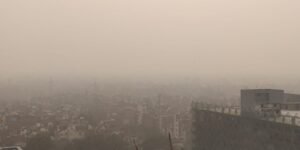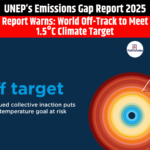Delhi Air Quality in Very Poor Category
|
General Studies Paper II: Government Policies & Interventions, Environmental Pollution & Degradation |
Why in News?
According to SAFAR-India, Delhi’s air quality continued to remain in the ‘very poor’ category on 4 November 2025 with the AQI level of 309. Despite several measures and awareness drives, the choking air continues to affect daily life and public health.

Current Air Quality Status in Delhi (4 November 2025)
- Overall Air Quality Index (AQI) Level: On 4 November 2025, the city of Delhi registered an AQI of 309 according to the SAFAR-India, placing it firmly in the “Very Poor” air quality category according to data from SAFAR‑India. This level reflects a sustained deterioration of air quality as the post-monsoon and winter season sets in.
- Worst-Affected Areas: Several localities in Delhi recorded even higher pollution levels. For example, the sub-area Jahangirpuri reported an AQI reading up to 402, while Rohini hit around 392. Other hotspots included Anand Vihar (392), Vivek Vihar (391) Narela (388) and Dwarka (Sector 8) (~367) on the same day.
- Previous Year Data: According to monthly AQI data, the AQI for November 2025 (306) is higher than the same month in 2024 (285) and is significantly elevated compared to October 2025 (197) as per historical trend data.
- Pollutant Concentrations: Fine particulate matter (PM2.5) continues to dominate as the principal pollutant driving the poor air quality. At one monitoring station, PM2.5 concentrations exceeded 136 µg/m³ with an AQI equivalent well above 200. Coarse particles (PM10) also reached damaging levels.
|
What is the Air Quality Index (AQI)?
|
Major Causes Behind the Rising Pollution Levels in Delhi
- Stubble Burning: Every year in late October and early November, farmers in Punjab and Haryana burn leftover crop residue to clear their fields quickly for the next sowing season. This practice releases thick plumes of smoke containing fine particles and toxic gases into the atmosphere. In 2025, satellite data from SAFAR and ISRO indicated that over 230 farm fires were recorded on 2 November 2025. The smoke drifts toward Delhi due to prevailing northwesterly winds. The particulate matter from these fires mixes with existing urban pollutants, pushing the AQI into the “very poor” or “severe” range.
- Vehicular Emissions: Delhi has one of the highest vehicle densities in India, with over 1.3 crore registered vehicles as of 2025, according to the Delhi Transport Department. Cars, trucks, buses, and two-wheelers release nitrogen oxides, carbon monoxide, and particulate matter. These pollutants form a significant portion of the city’s total emissions load. During peak traffic hours, emissions increase sharply due to idling and slow movement.
- Industrial Emissions: The industrial sector contributes heavily to Delhi’s pollution load. Small-scale units operating on the city’s outskirts and in neighboring regions such as Ghaziabad and Bahadurgarh often use low-grade fuels like coal, furnace oil, and biomass. These release high concentrations of sulfur dioxide (SO₂) and nitrogen dioxide (NO₂). Data from the Central Pollution Control Board (CPCB) show that industrial areas regularly exceed safe pollutant levels. Construction and demolition activities across Delhi also add to the dust burden.
- Urban Infrastructure: Dust is one of the most persistent sources of particulate pollution in Delhi. Unpaved shoulders, ongoing metro and road projects, and poor waste management contribute significantly. Road dust accounts for nearly 38% of PM10 levels, according to the CPCB’s 2024 report. As a result, even non-industrial and residential areas record high dust concentrations.
- Meteorological Conditions: In November 2025, Delhi experienced low wind speeds of 3–5 km/h and temperature inversions during early mornings. These conditions prevent pollutants from dispersing upward. The post-monsoon transition period also reduces vertical air movement, allowing smog to accumulate near the surface. Relative humidity levels around 70–80% increase the formation of secondary aerosols, making the air denser and hazier. Such weather patterns create a stable layer of pollution that lingers for days.
- Geographical Reason: The Indo-Gangetic Plain acts as a natural basin that traps pollutants over a wide area. Winds from Punjab, Haryana, and Uttar Pradesh carry smoke, dust, and industrial emissions into the capital. Also, the Himalayas block the escape route of the air, the dust and pollutants settle in the region.
Government Measures and Policy Interventions
- The Graded Response Action Plan (GRAP): The GRAP provides a stage-wise emergency framework to tackle air pollution in the Delhi-NCR region. It first came into effect in 2017, under the direction of the Supreme Court of India in the case of M.C. Mehta vs. Union of India. The GRAP defines four stages – Stage I (Poor: AQI 201-300), Stage II (Very Poor: AQI 301-400), Stage III (Severe: AQI 401-450), and Stage IV (Severe +: AQI >450). As pollution worsens, the measures escalate, and earlier stage actions continue to apply.
-
-
- When Stage I was invoked in the region, the authorities applied a 27-point plan across the NCR to arrest worsening air quality. These actions include: enforcing dust mitigation at construction and demolition sites, regulating vehicle emissions, pressing for proper waste disposal and banning burning of solid waste.
- When Stage II came into force, further 12-point action plan measures were applied such as daily mechanical road sweeping, water-sprinkling on roads, restricting diesel generators, limiting entry of older vehicles and restricting inter-state buses not on clean fuel.
-
- The National Clean Air Programme (NCAP): The NCAP was launched in 2019 by the Ministry of Environment, Forest & Climate Change (MoEFCC) with an initial target of reducing particulate pollution (PM2.5/PM10) by 20-30 % by 2024 (from 2017 baseline). Later the target was revised to up to 40 % reduction by 2026. The programme identifies over 130 non-attainment cities across India where annual average pollution exceeds standards, and mandates city-specific action plans, monitoring networks and funding.
- Regional Initiatives: The government of Delhi has also taken local measures. When Stage II of GRAP was invoked, the New Delhi Municipal Council (NDMC) doubled parking rates at off-street and multilevel facilities for private vehicles to discourage personal vehicle use.
- The Delhi government restricts construction activity, monitors diesel generator use, ban on old fossil fuel vehicles and implements odd-even vehicle schemes when air quality hits severe levels.
-
- The government mandated green plans for large hospital campuses to curb vehicular emissions, use cleaner fuels, and deploy anti-smog devices.
- The government also set vehicle norms like Bharat Stage VI and ban on firecrackers.
Impact of Rising Air Pollution in Delhi
- Public Health: Air pollution has become one of the most serious health concerns in Delhi. According to AIIMS, the number of patients reporting respiratory problems increased in 2025. Doctors have also noted a sharp rise in cases of asthma, chronic cough, and allergic bronchitis. The PM2.5 concentration in the air damages the lungs, reduces oxygen absorption, and leads to cardiovascular diseases. Children and the elderly are most at risk because their lungs are more sensitive.
- Ecosystem: The constant layer of smog does not only harm people but also affects the environment. The Central Pollution Control Board (CPCB) recorded high levels of sulfur dioxide (SO₂) and nitrogen oxides (NOx), which contribute to acid deposition. These gases damage plants, reduce crop yield, and alter soil chemistry. Reduced sunlight penetration also limits photosynthesis in urban trees. Water bodies like the Yamuna River suffer from increased silt and particulate deposition, lowering water quality and oxygen levels.
- Economic Loss: Air pollution also causes significant economic damage. A report by the Energy Policy Institute at the University of Chicago (EPIC) estimated that Delhi loses nearly USD 6 billion annually due to pollution-related health costs and productivity loss. Workers who fall sick more often take frequent leaves, reducing overall output in both formal and informal sectors. These micro and macro losses together impact the city’s economic growth and burden public health infrastructure.
Way Forward
Delhi’s fight against air pollution needs continuous and collective effort. Authorities should strengthen real-time monitoring, enforce pollution control laws strictly, and promote public transport and electric mobility. Along with this, industries should shift to cleaner fuels, and construction sites must follow strict dust control norms. Clean air must become a shared goal, where policy, technology, and public participation work together for a healthier, safer Delhi.
|
Also Read: First-ever ARTIFICIAL RAIN in Delhi |








